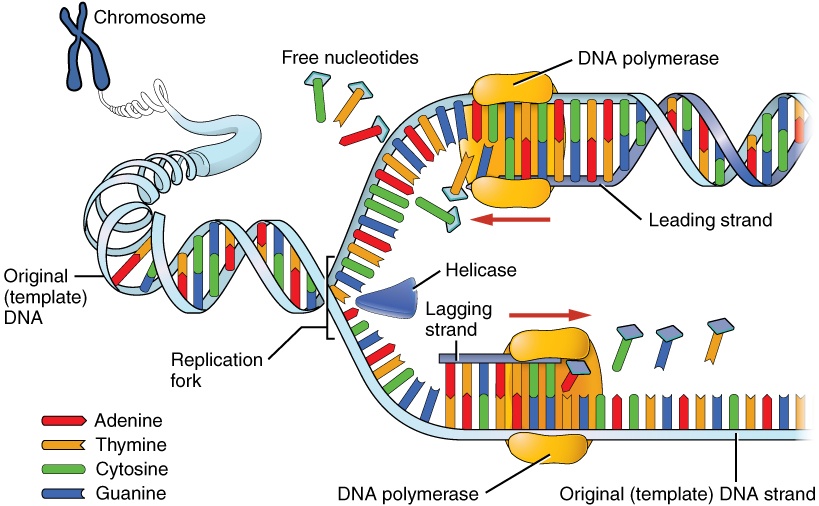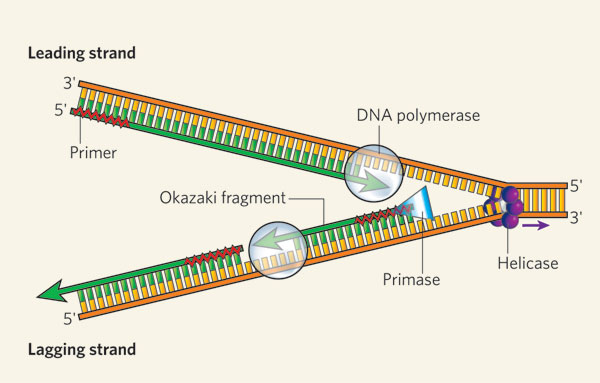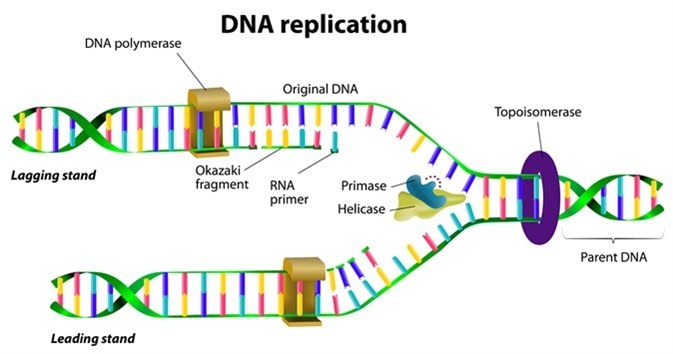Which Best Describes Okazaki Fragments in Dna Replication
In the 3 to 5 or 5 to 3 direction D. As 5 to 3 Okazaki fragments in an overall 3 to 5 direction only B.

Dna Replication Genetics Quizizz
During DNA replication Okazaki fragments are used to enlongate.

. Which of the following best describe the arrangement of an Okazaki fragment. It does this by adding DNA nucleotides one at a time. DNA primase is used for the entire reaction therefore eliminating the production of Okazaki fragments that normally result from the activity of DNA polymerase.
While protein synthesis machinery is found in the _____ of the cell. DNA polymerase I and ligase. At a specific area of a chromosome the sequence of nucleotides below is present.
The DNA polymerases II and III. Question 8 1 point Which of the following is NOT a function of any DNA polymerase during replication. Which of the following best describes Okazaki Fragments.
The range of length of these fragments in the bacterial cells is about 1000-2000 nucleotides while that in eukaryotic cells is. The lagging strand of the DNA can be described as the strand that forms in the direction of 3-5. 4 The lagging strand away from the replication fork.
Which pair of enzymes removes the RNA primer and seals the DNA nicks. The number of DNA molecules is doubled with every other replication. Okazaki fragments are the short lengths of DNA that are produced by the discontinuous replication of the lagging strand.
It is formed in fragments which are known as the Okazaki fragments. It does this by adding DNA. Leading strand synthesis occurs continuously.
How does DNA ligase function during DNA replication. To do this process Ligase fills in the gaps in between the Okazaki Fragments. Which of the following best describes semiconservative replication.
Okazaki fragment A short segment of DNA synthesized on a template strand during DNA replication. 1 The leading strand towards replication fork. DNA polymerase III and helicase.
Fragments of newly synthesized lagging strand DNA c. Try to include as many relevant proteins and concepts as possible to help demonstrate an understanding eg. Since this direction is opposite to the direction of the replication fork hence the lagging strand is not formed continuously.
The translation of a DNA molecule into a complementary strand of RNA. Which statement best describes strand characteristics as it relates to DNA replication. 4 The lagging strand away from the replication fork.
Many Okazaki fragments make up the lagging strand of newly synthesized DNA. This means that one strand has a series of breaks in the sequence. During DNA replication the lagging strand is complemented with Okazaki fragments that still contain the RNA primer.
As 5 to 3 Okazaki fragments in an overall 5 to 3 direction only C. DNA or the instructions for making proteins is found within the _____ of the cell. The polymerase α begins each Okazaki fragment on the lagging strand with RNA and then extends the RNA primer with a short length of DNA before passing the 3 end of this primer to a second enzyme DNA polymerase δ.
Okazaki fragments are short sequences of DNA nucleotides which are synthesized discontinuously and later linked together by the enzyme DNA ligase to create the lagging strand during DNA replication. By gluing them together with phosphodiester bonds between the phosphate. A It helps keep the DNA strands separated after the replication fork.
This second DNA polymerase then synthesizes the remainder of each Okazaki fragment with the help of a clamp protein Figure 5-28. The DNA synthesized on the leading strand Clear my. C It adds nucleotide bases to the newly synthesized DNA strand.
DNA ligase connects the Okazaki fragments and seals the breaks in the sugar-phosphate backbone. Lagging strand synthesis occurs in the same direction as the replication fork. 2 The lagging strand towards replication fork.
DNA polymerase is an enzyme that builds new strands of DNA. At DNA replication forks the overall growth of the antiparallel two daughter DNA chains appears to occur 5-to-3 direction in the leading-strand and 3-to-5 direction in the lagging-strand using enzyme system only able to elongate 5-to-3 direction and I describe in this review how we have analyzed and proved the lagging strand multistep synthesis reactions called. The replication of DNA never takes place with 100 accuracy.
The leading strand is built continuously and the lagging strand is built in pieces. Fragments of newly synthesized leading strand DNA an RNA primer d. B It joins together the Okazaki fragments produced from the lagging strand.
Fragments of newly synthesized leading strand DNA e. DNA polymerase III and primase. DNA Helicase Okazaki Fragments etc.
Okazaki fragments are short sequences of DNA nucleotides which are synthesized discontinuously and. A Ligase b Helicase c DNA polymerase. D It unwinds the DNA double helix.
Imagine there is an unlabelled diagram in front of you to guide your explanation. Biology Assignment Help Describes why okazaki fragments are not observed in pcr Which of the following best describes why Okazaki fragments are not observed in PCR. A removing RNA primers Ob closing up the nicks between Okazaki fragments O c proofreading and correction d synthesizing in the 5 to 3 direction 3 Question 9 1 point Which of the following best describes the three-dimensional structure of.
These portions are called Okazaki Fragments. Since the primers are made up of RNA they will have to be replaced by DNA bases. Also plays a key role in repairing single stranded breaks in duplex DNA in living organism.
They were discovered in the 1960s by the Japanese molecular biologists Reiji and Tsuneko Okazaki along with the help of some of their colleagues. 13 Which of the following best describes the function of DNA ligase. During DNA replication new nucleotides are added at the 3 end of the molecule.
A DNA molecule consists of one parental strand and one new strand. Which of the following best describes the direction in which lagging strands are added. A primase polymerase ligase B 3 RNA nucleotides DNA nucleotides 5 C DNA polymerase I DNA polymerase III D 5 DNA to 3 E 5 RNA nucleotides DNA nucleotides 3 4.
DNA polymerase is an enzyme that builds new strands of DNA. DNA ligase is a specific type of enzyme that facilitates joining of DNA strands together by catalyzing formation of a phosphodiester bond. Up to 24 cash back On the lagging strand there are portions of synthesized DNA.
3 The leading strand away from replication fork. Okazaki fragments remain in the DNA. Describe the process of DNA replication as if explaining it to a fellow classmate.
This statement is correct.

Dna Replication Of The Leading And Lagging Strand Learn Science At Scitable

Dna Replication Leading Strand Vs Lagging Strand Okazaki Fragments Youtube

No comments for "Which Best Describes Okazaki Fragments in Dna Replication"
Post a Comment